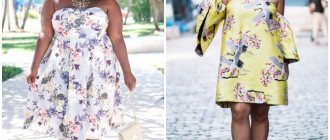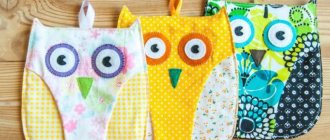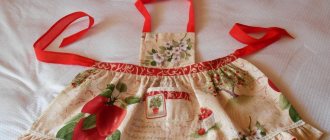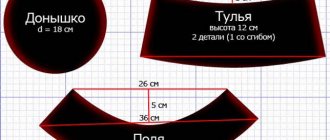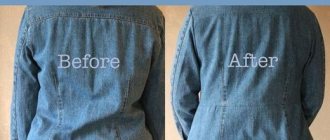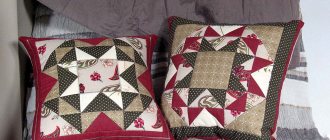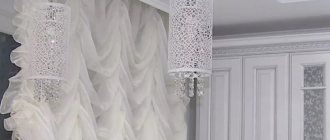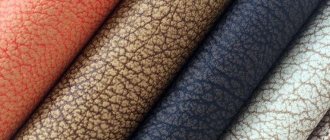Sewing children's pajamas is one of those jobs that beginner craftswomen can safely take on. The difficulty level is quite easy, the fabric consumption is less than for clothes for an adult. In addition, if small errors are made during work, then this is not a problem, because pajamas are intended only for home use, and even at night.
This is the kind of children's pajamas we will sew today
If you have a desire to sew something necessary and useful for a child, then this article is for you. Just below you can download PDF patterns for children's pajamas for ages 9, 10, 11 and 12 years. There are also options for children from 1 to 14 years old - these are patterns from Marlene Mukai.
Pajamas in the wardrobe
For a comfortable sleep, there is nothing better than beautiful and stylish pajamas. It can be presented in a wide variety of variations, from different materials. Fabric and finished goods stores are ready to offer their customers a wide range of goods for every taste.
However, the most original pajamas can be made with your own hands at home. At the same time, it is not necessary to have special skills and craftsmanship; it is enough to have proper command of a needle and thread. And step-by-step instructions and video lessons from experienced needlewomen will allow you to master a further sewing course.
Types of pajamas for independent work
Any pajama model contains two main elements: the top and the bottom. In this case, the upper half can be presented in the form of a T-shirt, T-shirt, light top or insulated blouse with long sleeves.
The lower part can also be sewn in the form of trousers, short shorts or medium-length breeches. The tailoring form is chosen depending on the season of the year, the type of heating in the apartment (private house) and the personal wishes of the owner.
Shape selection
There are a lot of models of children's pajamas. For example, for girls 4-7 years old, a home suit of trousers or breeches and a sweatshirt or T-shirt is suitable - it all depends on the type of fabric and time of year. And for boys 3-5 years old, shorts or pants and a T-shirt with long or short sleeves are usually sewn. For 2-year-old children, it is better to choose sleep suits with buttons or rivets in order to quickly and easily change the baby’s clothes at night if necessary. And babies under the age of 1 year are more comfortable sleeping in warm and cozy “little men” (slips), which are relevant at any time of the year.
For children 3-5 years old, pants and a long-sleeved T-shirt are usually sewn, and for children 2 years old it is better to choose sleep suits with buttons.
When choosing a model, the mother needs to focus on the usual temperature in the nursery, consider whether the baby sleeps at night with the window open and whether he likes to cover himself with a blanket. And, of course, it is better to ask the opinion of a little fashionista or fashionista in advance, so that the child puts on pajamas with pleasure and goes to bed in a good mood.
Step-by-step sewing pajamas
When starting work, you must remember that inexperienced craftswomen should begin their independent work with simple work. It is better to give preference to simple pajama models that do not have auxiliary decorative details, intricate buttons, hooks, or cords.
You should also consider the purpose of the homemade product. For a young child, it is better to choose pajamas without fasteners or small parts that the child can tear off and accidentally swallow.
Selection of tools for work
You should begin independent cutting and sewing activities by organizing your workplace. Working with a needle and thread requires painstaking work and constant eye strain. In order to reduce the load on the muscles of the back, arms and shoulders, carefully select the height of the table and chair.
To relieve the eye muscles, you should prepare the optimal level of natural and artificial lighting. You will also need the following set:
- A set of patterns for preparing patterns.
- Sharp scissors that will not tear the edges of textiles.
- Tape measure.
- Pencil.
- Sewing machine.
- Decorative elements (if they are provided for this model).
- Threads and needles for hand stitches.
Step-by-step instructions for sewing pajamas with a detailed description of each stage of the work may also be useful (for example, how to sew silk pajamas with short shorts).
Selection of materials for sewing
The next stage in independent work is the optimal selection of the textile base. In this case, first of all, a number of individual characteristics of the future owner are taken into account:
- Age.
- Presence of allergic reactions.
- Sensitivity of the skin.
Today there are three groups of fabric bases on sale: made from natural threads, synthetic and combined fabrics. Each presented option has a number of pros and cons as a practical choice.
Natural fabrics allow air to pass through perfectly, allowing the skin to breathe. In addition, they do not heat the skin, do not absorb unpleasant odors, and do not cause allergic reactions. However, despite the presence of a large number of advantages, such canvases are not without disadvantages.
Pajamas made exclusively from natural fibers quickly lose their shape, shrink, and lose their original color. Synthetic fibers are durable, resistant to frequent washing, and do not lose color. However, for children's pajamas this option is absolutely unacceptable due to frequent allergic reactions on delicate skin.
Artificial fabrics do not allow air to pass through well, can irritate the skin, and also quickly absorb sweat odors. For this reason, mixed types of textiles, in which natural and synthetic threads are in optimal proportions, are very popular today.
What you need
One of the most important points is the choice of fabric for sewing children's pajamas. The main requirements that sleep and rest kits must meet are comfort and safety. Therefore, when buying material for work, you first need to pay attention to its composition. The priority is 100% natural fabrics in which the child’s skin will breathe freely. The ability of matter to absorb moisture well and retain heat is also important. And, of course, ease of care: children's pajamas should be easy to wash, both by hand and in a washing machine, dry quickly and iron at normal temperatures.
It is better to make children's pajamas for autumn-winter from flannel, thick knitwear or terry cloth. Flannel sleepsuits are soft and cozy to the touch, retain heat well and keep you warm in cold weather. They can also last for more than one season: flannel is highly durable and wear-resistant, does not stretch after washing and does not lose shape when worn. Knitted pajamas allow air to pass through well, practically do not wrinkle and do not require special, delicate care. And terry is generally considered one of the warmest fabrics, which also absorbs moisture well and creates a feeling of comfort and coziness.
To ensure that your baby really likes the finished pajamas, it is advisable to buy fabric in his favorite color, or even better, with images of funny animals or cartoon characters.
The best option for hot summer nights is cotton pajamas. Calico children's sets are very popular. This is a soft, easy to sew and inexpensive fabric with high hygroscopicity and a huge selection of bright colors. In cotton pajamas, a child will never sweat even in a stuffy room, which means that the baby’s sleep will be deep and healthy.
Don't forget about the appearance of the material. To ensure that your baby really likes the finished pajamas, it is advisable to buy fabric in his favorite color, or even better, with images of funny animals or cartoon characters.
You need to be especially careful when choosing home clothes for a child with allergies. Here you will need not just absolutely natural fabric, but also without bright patterns throughout the entire fabric to avoid contact of children's skin with dyes
A safe option is a material with a printed pattern, which is applied only to the outside of the fabric.
In addition, for work you will need a standard set of sewing supplies: a measuring tape, scissors, a needle and pins, a chalk or a piece of soap, matching threads, an elastic band and a sewing machine.
This is interesting: Pattern for Children's Panama Hat
Preparation of patterns
In any situation, an inexperienced needlewoman has the opportunity to use ready-made patterns. However, if you want to sew pajamas with a unique design, you should measure the chest circumference, neck circumference, and waist circumference.
Next, you should calculate the height of the armhole and collar for the sleeve. For the lower part, you will need to calculate the circumference of the hips and the length of the trouser leg. For long pajamas, you should first calculate the width of the calf muscle. All results obtained must be transferred to paper using a pencil and ruler.
Pattern for children's pajamas for ages 9, 10, and 12
For work you will need the following materials:
- knitted fabric: for size 9: 1 m for trousers, 60 cm for a jacket. For each subsequent size + 25 cm
- pattern,
- elastic band (elastic band): size 9 - 58.5 cm; size 10 - 61 cm; size 11 - 63.5 cm; size 12 - 66 cm.
Seam allowances 1 cm.
Parameters for size 9: waist: 56 - 63 cm, jacket length: 53.5 cm, sleeve length: 56 cm. Designed for a 9-year-old child of normal build and age-appropriate height.
Children's size chart
If you don't have an overlocker, we recommend using a zigzag stitch.
Pattern for children's pajamas
Download and print the PDF file with the pattern at 100% scale. Glue the sheets together and cut out the pattern to the desired size.
Download a free pattern for children's pajamas, sizes 9 to 12 years.
How to sew children's pajamas
Sweater
Separately, you need to cut out the details:
18 x 15 cm - 2 pcs. (cuffs),
30 x 15 cm - 2 pcs. (elastic band for the bottom of the jacket),
38 x 6 cm - 1 piece (for the neck).
Fold the cuffs in half and sew to the sleeves, stretching the fabric slightly.
In the same way, sew strips of fabric folded in half to the bottom of the back and front pieces.
Fold in the front and back of the faces. parties. Sew the shoulder seam on the left side, leaving the right shoulder seam open.
Pin the left sleeve, starting from the center. Place a line.
Fold the strip intended for the neck in half and sew it to the cut of the neck, similar to the previously sewn strips of fabric.
Sew the right shoulder seam.
Sew the right sleeve, like the left one, first align the parts with pins.
Sew the right side seam and sleeve in a single stitch. Sew the same way on the other side.
Cut the threads. The pajama jacket is ready.
Master class: how to sew a pajama top
Preparing parts and assembling the product
The final stage, also known as the main stage of independent work, is carried out according to the following instructions on how to sew pajamas with your own hands for beginners:
- The prepared textile fabric is washed to provide the first shrinkage for the fabric.
- Then the textiles are carefully smoothed with an iron.
- Using pre-prepared patterns, parts for assembly are cut out: a single piece of the front, two parts of the back, sleeves (if necessary), parts of the bottom.
- During the marking process (on the reverse side of the textile), be sure to leave 1.5-2.0 cm of fabric for the seams. When cutting out elements, use only sharp sewing scissors, which will not leave nicks or uneven cuts.
- The edges of the textile left on the seams are smoothed with an iron.
- Using a thread and a needle, mark the joints of the parts with hand stitches. The work uses the technique of large hand stitches, which can then be easily removed.
- For a T-shirt or light top, straps are sewn on, the edges of the neckline and cutouts are tucked in. They are also basted with large hand stitches.
- The next task facing the craftswoman is working with a sewing machine. All hand stitches must be duplicated with neat line stitches.
- After assembling the lower part (pants legs, short shorts, breeches), the upper contour is stitched, leaving a small channel inside. An elastic band or cord is passed through this channel to hold the pajama pants on the hips.
For edge sections (neckline, sleeves or hem), you can use beautiful decorative stitches. Also for adult pajamas, lacing is used on the front surface of the T-shirt, small buttons, and soft Velcro. For independent work, you can use detailed instructions on how to sew pajamas from satin with lace. Such accessories will become a real decoration of the wardrobe of any fashionista.
For children's pajamas, there are a number of tailoring features: there must be a complete absence of small parts that will rub the baby's delicate skin. It is also better to avoid excess seams, fasteners, and buttons.
Cut out the blouses
Lay the baize face up on the workbench and identify the grain thread. Fold the blouse in half, fold the edge of the jacket so that the width of the resulting fabric is equal to the width of ½ of the jacket + seam allowance, place the jacket on the fabric (Fig. 2).
Carefully outline the jacket, mark the allowances (Fig. 3).
Cut out and unfold the back piece (Fig. 4).
Similarly, cut out the front of the blouse, deepening the neckline, as well as 2 sleeve parts (Fig. 5).
From elastic fabric, cut out and cut out a cuff with a length equal to 2/3 of the sleeve width and a width of 7-10 cm (Fig. 6), as well as a stand-up collar.
